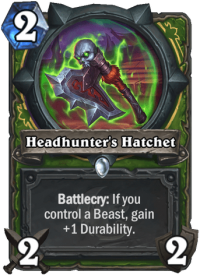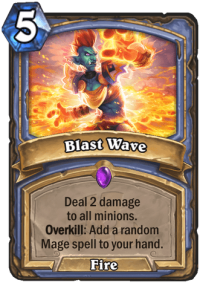Team 5 now has many different tools to change up the Arena experience, some of which are more subtle than others – a good example of this would be the latest set of micro-adjustments that pushed down Warrior, Rogue and Hunter from the top three position. Conversely, the old draft and play strategies are no longer optimal as a new monster is on the rise: the axis of this new universe happens to be Warlock, a class that is capable of an incredibly consistent strategy that you should always be planning around.
A New Warlord
The collapse of consistency in Warrior drafts clearly pushed the Arena metagame into a more tempo-oriented direction. The biggest winner of the changes is Warlock, though not in the way you might imagine at first: while the class has usually relied upon a set of ultra-powerful AoE and late-game options (Defile, Despicable Dreadlord, Omega Agent, Voidlord and such), the most important element right now is the extreme misbucketing of Demonbolt. It is an auto-pick in its current form, and the increase in Rumble cards make it even more likely that you can draft multiple copies of it. In turn, it encourages an aggressive playstyle with many small minions – essentially a Zoo-like strategy.

This turns many of your previous drafting decisions upside down. Since you’re always going to have a board lead, premium double-sided board clears like Hellfire and Defile are suddenly undesirable cards. So are many powerful cards that are bundled together with Flame Imp and Kobold Librarian, absolute MVPs of this drafting style. A Warlock deck with a consistent early curve (think at least 3-4 one-drops, 5-6 two-drops and around the same number of 3-drops as well) will hardly require any support from spell-based initiative beyond Demonbolt. Typically excellent cards like Stubborn Gastropod and Stoneskin Basilisk are also traps: your gameplan revolves around pushing damage in the early turns and playing an aggro-control style from that point on (for those unfamiliar with the term, it essentially means that you keep dealing repetitive damage with the first few minions you established on the board, consistently trading with the threats you’ve deployed later to ensure their continued survival). Successful Zoo decks will very rarely have burn, therefore it is imperative that you stay ahead on the board for the entirety of the game. This is something you should keep in mind when playing against Warlocks as well. This drafting style is incredibly consistent and you can always steer your deck in this direction as long as you’re consciously trying to do so from the very first pick: at the time of writing, I’ve got an average of 8.6 over eight runs with this strategy, and every single Warlock opponent I’ve encountered at high wins had the same archetype.
An Escape Hatch(et)
While Rexxar is rooted to the bottom of the HSReplay charts at the time of writing, some of that has to do with players clinging to the mid-range drafting style that worked very well previously.

With the lowered offering rate of important cards of this archetype – perhaps most importantly, Baited Arrow –, the collapse in the class’ winrate has a lot to do with a lack of adaptation. Not only does that style not mesh well with the many Zoo decks in the Arena, it’s also become a lot less consistent as a drafting option. However, a hyper-aggressive style aiming to crush Warriors and beat Warlocks to the punch can still yield good results, and it is arguably still a more enticing proposition than Shaman or Druid in the current environment.
This is also how Paladins can find a way to victory in the Arena right now: while there’s certainly an argument to be made about hiding behind Divine Shield-imbued Taunts via A New Challenger..., it’s often going to work out better for you if it ends up protecting the minions you’ve previously established on the board instead of just your face. Slower Paladin drafts can go wrong fairly easily – though it’s not to be entirely discounted with the right selection of cards, unlike a control Warlock –, but seeing how the premium class weapons (Silver Sword and Vinecleaver) operate in the late game, it often makes more sense to go aggressive instead of putting your faith in the Light. Arguably, Rogue does the same thing but better, still a viable option despite yet another adjustment to the rate their premium tools are offered: however, they can’t hold a candle to Warlocks in that regard.
Controlling Crowds
That’s not saying the entire metagame is exclusively pushed towards aggro builds: Warrior is still really good at doing Warrior things, though the prevalence of Zoo-esque decks means that more initiative is needed than usual. This gives an opportunity to Priests and Mages to capitalize by going for greed, creating an odd little subsection of the metagame where certain classes try to out-greed each other without completely losing to aggressive strategies.

Mage happens to be second on the winrate charts, simply off the back of the monstrous capabilities of Blast Wave. The subtle changes in offering rates moved Jaina ahead of Garrosh in the control wars, though it’s important to keep in mind during drafts that there are less removal options on offer than you might be used to, meaning you have to pick up a chunky enough early curve so that you don’t get run over. On the flipside, this also allows you to take the tempo lead in the slower matchups, which is why Mage is currently in a pretty good position.
Two classes were omitted from the discussion from above, and there’s a good reason for that: neither Shaman nor Druid can consistently draft a style that can combat the aforementioned archetypes, which is why I’d recommend treating them as the bottom two even if Hunter has a lower global winrate. Supposedly, good players can find a lot of edges in the 13.0 Arena meta by going mid-range and finding the small edges – personally, I would recommend pure aggression, Blast Waves and Warpaths be damned.



